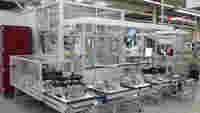Flexible I/O System for All Fieldbus Protocols

In its production lines, the automotive supplier Brose depends on decentralized automation using robust and reliable components, designed according to IP20. Low installation space demands, simple and fast expandability, and the ability to integrate different bus systems are the more important requirements here. The WAGO 750 Series I/O System and WAGO’s EPSITRON® Electronic Circuit Breakers (ECBs) are used.
Your Benefits with the WAGO-I/O-System:
In fact, select I/O modules can accommodate up to 16 channels in a narrow 12 mm (1/2”) housing.
DeviceNet, CAN or PROFIBUS: The WAGO-I/O-SYSTEM supports all conventional fieldbus protocols and ETHERNET standards.
Modular design

